
USS Fletcher (DD/DDE-445), named for Admiral Frank Friday Fletcher, was the lead Fletcher-class destroyer, and served in the Pacific during World War II. She received fifteen battle stars for World War II service, and five for Korean War service.

USS McGinty (DE-365) was a John C. Butler-class destroyer escort of the United States Navy.
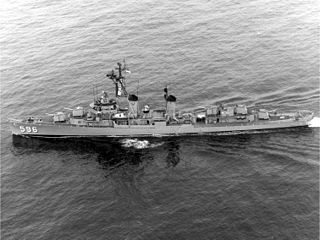
USS Shields (DD-596), was a Fletcher-class destroyer of the United States Navy.

USS Osmond Ingram (DD-255/AVD–9/APD-35) was a Clemson-class destroyer in the United States Navy during World War II. She was named for Gunners Mate First Class Osmond Ingram, who posthumously received the Medal of Honor.

USS Naifeh (DE-352) was a John C. Butler-class destroyer escort in service with the United States Navy from 1944 to 1960. She was sunk as a target in 1966.

USS Acree (DE-167) was a Cannon-class destroyer escort in service the United States Navy from 1943 to 1946. She was scrapped in 1973.

USS Herndon (DD-638), a Gleaves-class destroyer, was the second ship of the United States Navy to be named for Commander William Lewis Herndon.

USS De Haven (DD-727), an Allen M. Sumner-class destroyer, was the second ship of the United States Navy to be named for Lieutenant Edwin J. De Haven. De Haven served aboard the Vincennes, flagship of the Wilkes Expedition, officially known as the United States Exploring Expedition, from 1839 to 1842. De Haven also served in the Mexican–American War, assisting in the capture of the Mexican schooner Creole. He was placed on the retired list in February 1862. He died in Philadelphia on 1 May 1865.
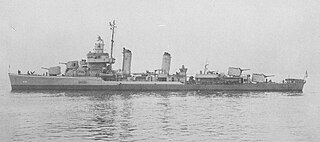
USS Earle (DD-635/DMS-42), a Gleaves-class destroyer, is the only ship of the United States Navy to be named for Rear Admiral Ralph Earle.

USS Davison (DD-618/DMS-37), a Gleaves-class destroyer, was named for Lieutenant Commander Gregory C. Davison (1871–1935). Davison specialized in torpedo boat operations.
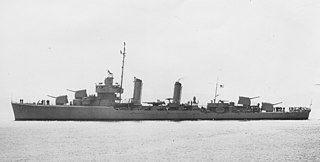
USS Carmick (DD-493/DMS-33), a Gleaves-class destroyer, was the only ship of the United States Navy to be named for Major Daniel Carmick (1772–1816), an officer in the United States Marine Corps who served during the Quasi-War with France and during the War of 1812.

USS Marsh (DE-699) was a Buckley-class destroyer escort of the United States Navy.

USS Parker (DD-604) was a Benson-class destroyer in the United States Navy during World War II. She was the second ship named for Foxhall A. Parker, Jr.

USS Whitehurst (DE-634), a Buckley-class destroyer escort of the United States Navy, was named in honor of Ensign Henry Purefoy Whitehurst, Jr., a crew member of the Astoria (CA-34) who was killed during the Battle of Savo Island in August 1942.
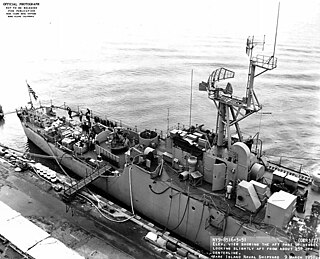
USS Joyce (DE-317) was originally commissioned as a US Coast Guard Edsall-class destroyer escort built for the U.S. Navy during World War II. She served in the Atlantic Ocean and the Pacific Ocean and provided destroyer escort protection against submarine and air attack for Navy vessels and convoys. During its World War II service, on two different engagements with enemy submarines, the Joyce rescued survivors of the tanker SS Pan- Pennsylvania and its sister ship USS Leopold. Joyce received one battle star for its service during World War II.

USS Hanna (DE-449) was a John C. Butler-class destroyer escort acquired by the U.S. Navy during World War II. The primary purpose of the destroyer escort was to escort and protect ships in convoy, in addition to other tasks as assigned, such as patrol or radar picket. She returned home with five battle stars to her credit after she was reactivated for Korean War duty.

USS Silverstein (DE-534) was a John C. Butler-class destroyer escort in service with the United States Navy from 1944 to 1947 and from 1951 to 1958. She was sold for scrapping in 1973.

USS Thomason (DE-203) was a Buckley-class destroyer escort in service with the United States Navy from 1943 to 1946. She was scrapped in 1969.
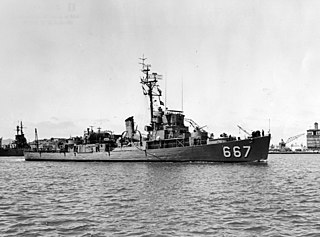
USS Wiseman (DE-667) was a Buckley-class destroyer escort in service with the United States Navy for several periods between 1944 and 1973. She was scrapped in 1974.

USS Tinsman (DE-589) was a Rudderow-class destroyer escort in service with the United States Navy from 1944 to 1946. She was sold for scrapping in 1973.




















